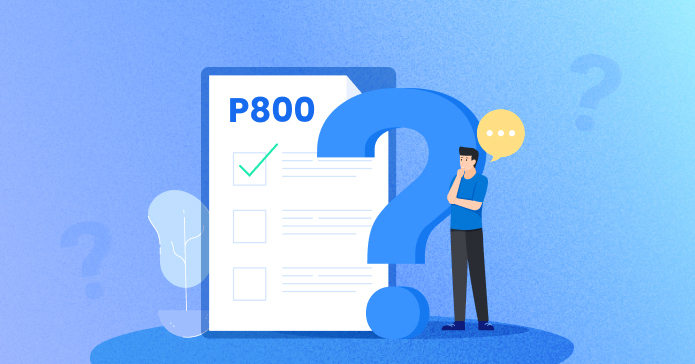Wading through the maze of tax calculations can feel like trying to find your way out of a cornfield blindfolded—challenging for taxpayers, business owners, and the self-employed alike. Enter the P800 form, the UK's tax equivalent of a surprise party invitation from HMRC! This little letter might just mean you're due for a refund. But do you knowing how to claim a p800 refund? That's the real party trick. Dive into our guide to unravel the mystery of the P800, from spotting it in your mailbox to happily claiming your refund!
What is a P800?
The P800 form from HMRC is your surprise update on your tax situation. Think of it as a tax report card, showing if you've overpaid or underpaid your taxes. Most taxpayers receive this letter after the tax season ends, typically from mid to late April. However, if HMRC detects any discrepancies in your tax payments, you could receive a notification at any time. Stay informed about your taxes and ensure accurate payments to avoid unexpected surprises!
Why the P800 Tax Form Matters
Understanding your P800 tax form is crucial for ensuring you pay the correct amount of tax. This form indicates whether you're eligible for a tax refund or need to pay additional taxes. Staying alert for this letter is essential for effective financial management.
What is Included in a P800 Tax Form?
The P800 tax form provides important information such as your total income for the tax year, taxes paid, tax-free personal allowance, and any claimed tax-deductible expenses. Familiarity with these details can simplify managing your taxes and avoid unexpected charges.
Stay informed about your taxes with the P800 tax form—it's a vital tool for accurate tax calculations and effective financial planning.
When Should I Receive a P800?
Usually, HMRC sends out P800 forms at the beginning of the tax year, so look for one in your mailbox from mid to late April. However, you might receive a P800 at other times if HMRC identifies discrepancies in your tax records.
Reasons You Might Receive a P800 Form
You could get a P800 form if you've changed jobs, have multiple income sources, or claim certain tax reliefs. These changes may prompt HMRC to review your tax situation.
How to Ensure You Receive Your P800 Form
To avoid missing your P800, regularly check your mail when the tax year starts. If it's late April and you haven't received it, but you think you should have, it's best to contact HMRC to check the status.
How Do I Get My P800 Online?
Getting your P800 tax refund online is simple and convenient. To access your P800, log in to your personal tax account on the HMRC website. If you don't have an account yet, create one using your National Insurance number and personal details.
How to Obtain Your P800 Tax Calculation Online
- Log into your HMRC personal tax account.
- Navigate to the 'Tax' section.
- Select the 'P800 tax calculation' option.
- Download your P800 form for review.
Benefits of Checking Your P800 Online
Viewing your P800 tax calculation online allows you to quickly verify and adjust your tax information if necessary. This method is faster and more convenient than waiting for postal delivery. Accessing your tax refund details online ensures you stay informed and up-to-date with your financial matters.
Will HMRC Automatically Refund Overpaid Tax?
Yes, HMRC usually processes overpaid tax refunds automatically. After sending you a P800 notification indicating you've overpaid, they'll either deposit the tax refund into your bank account or send you a cheque.
How Automatic Tax Refunds Work
If HMRC owes you a refund, they will use the bank details they have on file to process it. If they lack your bank information, they will mail a cheque to your address.
How to Ensure You Receive Your Tax Refund
To guarantee you receive your tax refund without any issues, ensure your bank details and address are up to date with HMRC. You can update this information through your personal tax account or by contacting HMRC directly.
Is a P800 the Same as a P60?
No, they're not. Understanding the difference between a P800 and a P60 is important for managing your taxes effectively.
What is a P60?
A P60 is a crucial tax document provided by your employer at the end of the tax year. It acts like a year-end report card, showing your total earnings and the amount of tax deducted from your salary.
What is a P800?
A P800 is a tax letter from HMRC. It details any discrepancies in your tax calculations, including whether you have overpaid or underpaid taxes.
Key Differences: P800 vs. P60
- P60: Issued by your employer, summarizing your annual income and tax deductions.
- P800: Sent by HMRC, detailing any tax discrepancies or adjustments.
When to Expect These Documents
You'll receive your P60 from your employer at the end of the tax year. A P800 will be sent by HMRC if there are any tax overpayments or underpayments.
Understanding these key tax documents helps you keep your finances in check and ensures you meet your tax obligations accurately.
The P800 Tax Calculation
The P800 tax calculation from HMRC is essential for ensuring you pay the correct amount of tax. If you've either underpaid or overpaid, HMRC will send you a P800 form by mail.
What Does the P800 Tax Calculation Include?
The P800 tax calculation includes details about your total income, the tax you've already paid, your tax-free personal allowance, and any tax-deductible expenses. These details determine whether you have overpaid or underpaid your taxes.
Why is the P800 Tax Calculation Important?
Grasping your P800 tax calculation is crucial for effective tax management. It helps you comply with tax regulations, avoid penalties, and ensures you receive any tax refunds you're entitled to. Understanding your P800 tax calculation can significantly benefit your financial planning and peace of mind.
Conclusion
Understanding the P800 process is crucial for taxpayers, business owners, and the self-employed, just like your morning coffee. This guide provides essential information on what a P800 tax calculation is, how to access it, and the steps to take once you receive it in your inbox. By staying informed and proactive, you can efficiently manage your taxes and claim any refunds owed to you.
For more information or assistance with your P800 tax form, visit the HMRC website or contact their customer service team. Effective tax management doesn't have to be overwhelming—equip yourself with the right knowledge and take control of your financial future!













